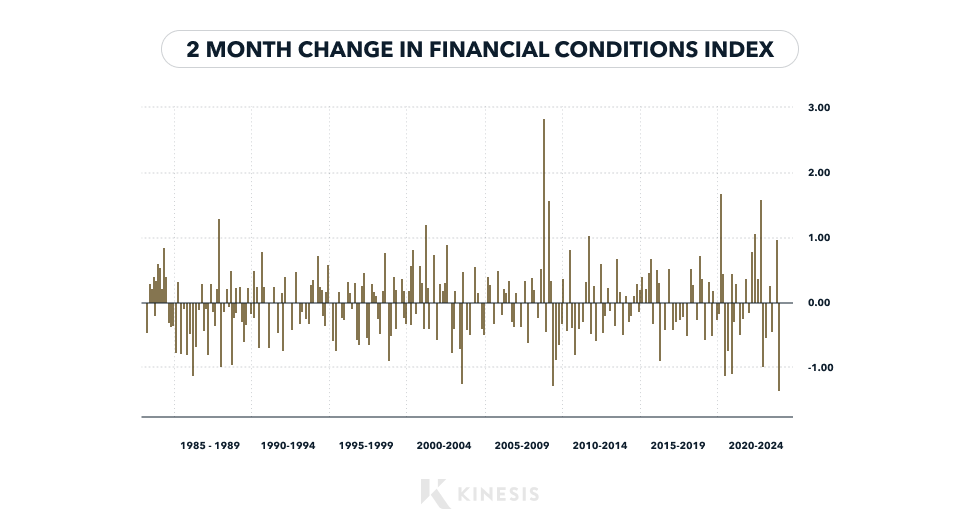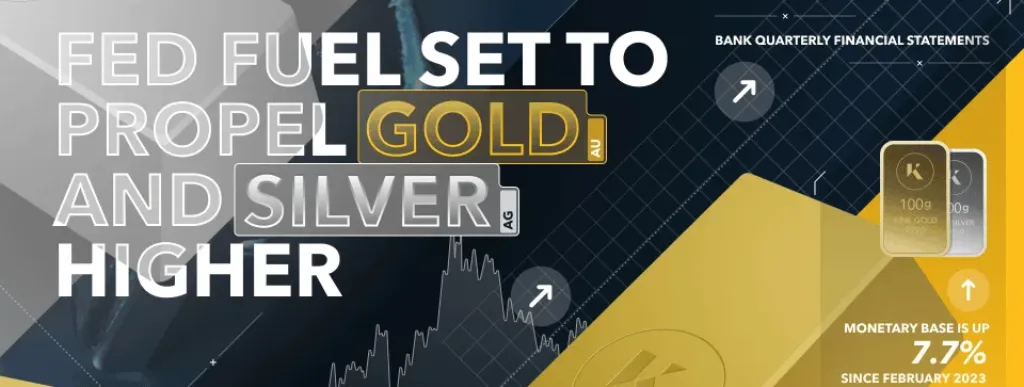The stock market bubbled in 2023 because the Fed, despite a gradual reduction in its balance sheet, has been injecting liquidity in various forms into the banking system.
This occurred explicitly in March 2023 when it printed $400 billion to resuscitate the regional banks. The Bank Term Funding Program, though small relative to the Fed’s balance sheet, is another form of banking system liquidity.
There are some other places through which the Fed is injecting liquidity into the banks but I believe they will have to crank up the printing press aggressively once again to fight a banking system and debt crisis. This will be the fuel that propels the precious metals sector.
Concerning the Fed’s implicit pivot on its interest rate policy at the November FOMC meeting, systemic financial conditions eased in November and December combined by the greatest amount over two months in the history of the metric.
Precious Metals vs Stocks in 2023

This frenetic easing of financial conditions orchestrated by the Fed is the reason the precious metals sector outperformed the stock market in the last two months of 2023. Between October 6th and the end of last year, the gold price increased from $1,823 to $2,071, or +13.6%.
Similarly, the silver price jumped from $20.85 to $23.76, or +14%. Over the same period, the S&P 500 rose 10% and the Nasdaq climbed 11.8%. The mining stocks as represented by GDX jumped 15.3% over that period.
Surprisingly, while gold and silver outperformed the stock market and GDX outperformed the S&P 500 by 50% from early October through to the end of 2023, there was almost zero commentary from the mainstream financial media.
It is this anonymity factor concerning the precious metals sector that makes it a textbook value investment play. The performance of gold, silver and mining stocks should be well set up by financial and economic tailwinds which will continue, if not intensify, in 2024.
Bank Quarterly Financial Statements
An examination of several individual banks’ quarterly financial statements revealed that the delinquency, default and charge-off rates are increasing, particularly in commercial real estate and household debt. For banks that emphasise consumer credit, the delinquency and default rates are much higher than the average across all banks. The rate of delinquency in subprime auto loans is higher than it was at its peak during the Great Financial Crisis era.
This financial stress in the banking system is hidden in plain sight, but mainstream media reporters recycle the narrative that the “banks are in good shape”. The financial stress at these banks has been subtly “papered over” by the Fed as described above. However, at some point, it will require considerably more liquidity creation than has been made available up to this point.
Rebirth of “QE”
2024 will likely witness the official rebirth of Quantitative Easing, but the Fed may label the program under something else (something like “Bank Term Funding Program”). The only question in my mind is the scale and duration of the precious metals sector bull move that I believe will unfold over the coming months and quarters in response to the next stage of full-blown money printing.
The Monetary Base (bank reserves plus currency/coin in circulation) has been rising since February 2023. This suggests that the Fed started injecting reserves into the banking before the regional bank crisis surfaced which indicates that the Fed knew what was coming. The Monetary Base is up 7.7% since February 2023.
Remember that the Fed removed the reserve requirement for banks in 2020, which means that the increase in bank reserves per the Monetary Base creates a “multiplier effect”. This is likely the reason behind the reflation of the stock bubble and the dramatic drop in Treasury yields at the long end of the yield curve.
While it seems obvious that the Fed will need to crank up the printing press in 2024 to keep the banking system solvent and to help fund the coming flood of new Treasury bond issuance, by some measures the Fed has already begun injecting liquidity into the banking system. The rising Monetary Base is just one indicator but it partially explains the unprecedented spike in financial conditions detailed above. Eventually, these monetary system developments will translate into much higher prices for gold and silver.
Dave Kranzler is a hedge fund manager, precious metals analyst and author. After years of trading expertise build-up on Wall Street, Dave now co-manages a Denver-based, precious metals and mining stock investment fund.
This publication is for informational purposes only and is not intended to be a solicitation, offering or recommendation of any security, commodity, derivative, investment management service or advisory service and is not commodity trading advice. This publication does not intend to provide investment, tax or legal advice on either a general or specific basis. The opinions expressed in this article, do not purport to reflect the official policy or position of Kinesis.
Read our Editorial Guidelines here.




